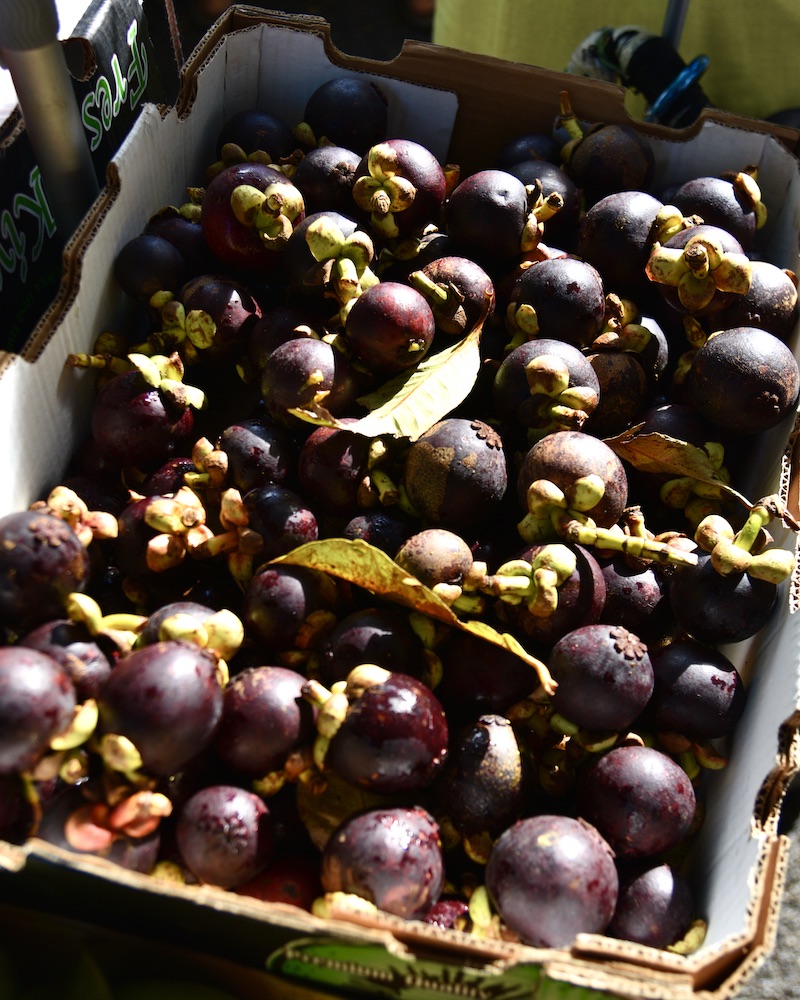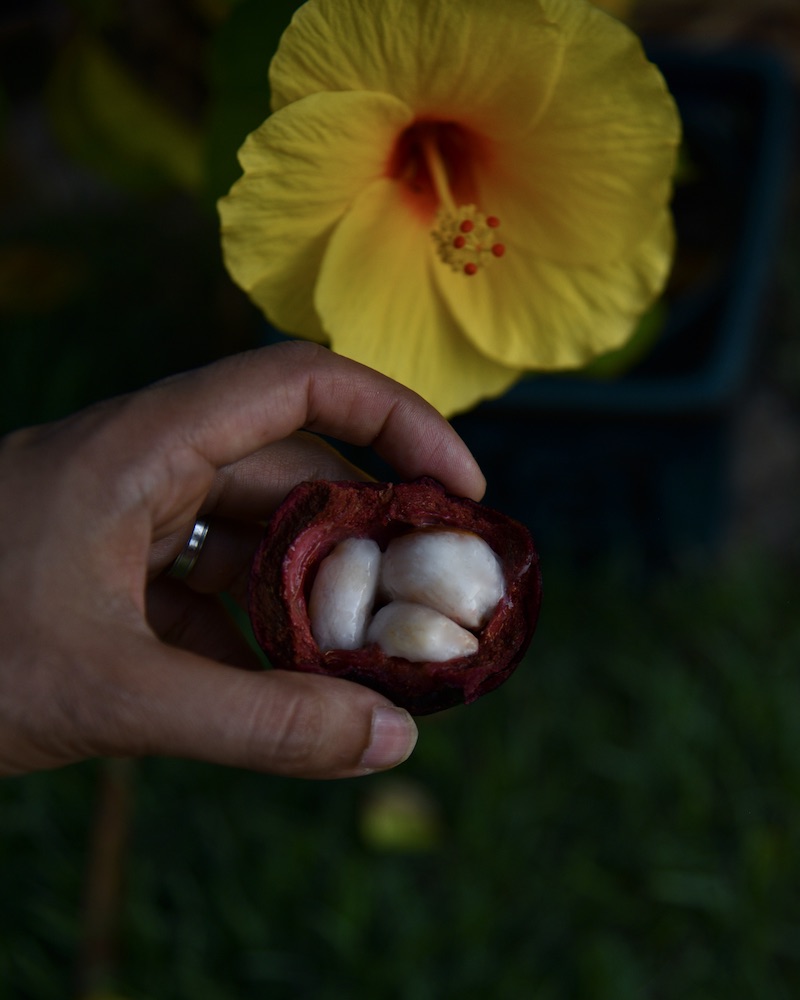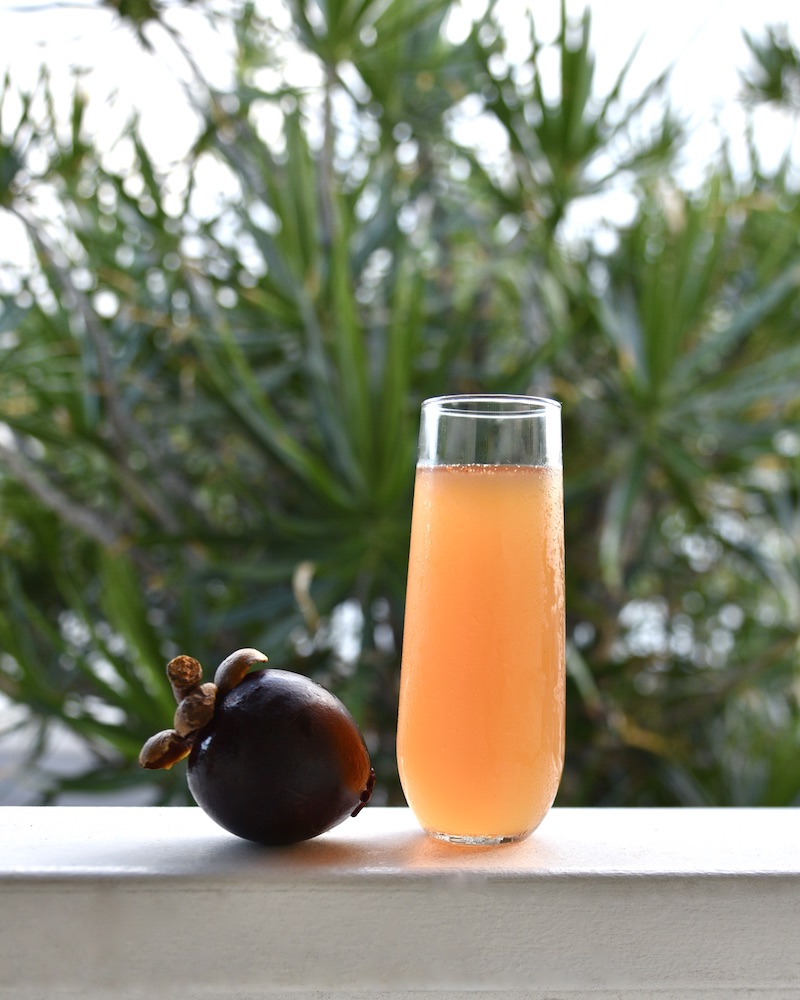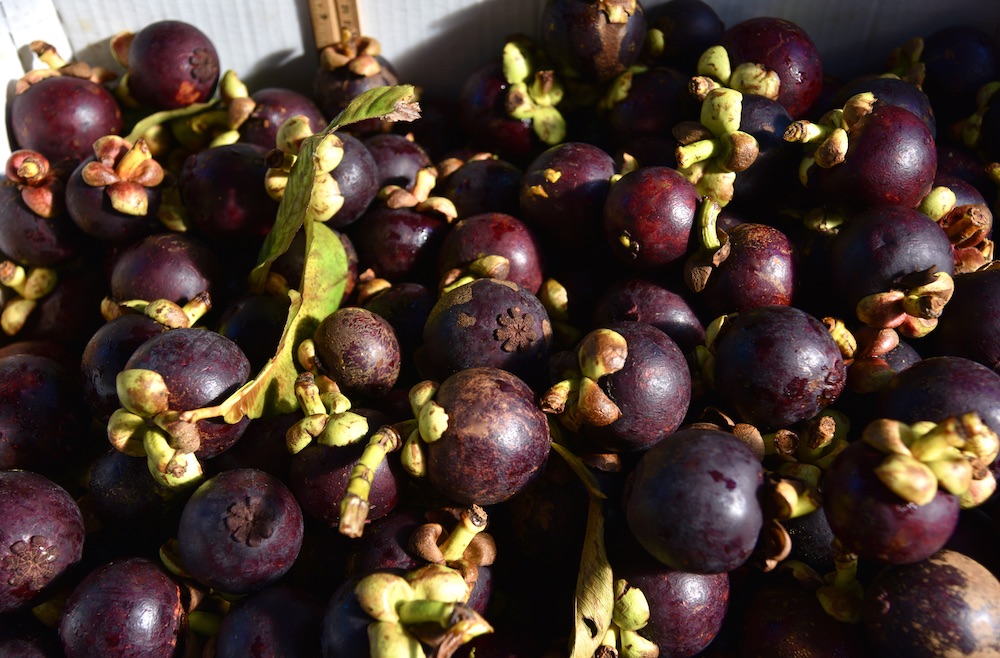I am so excited to share this easy recipe for making fresh mangosteen juice, aka Santol-ade: an electrolyte- and potassium-rich drink that tastes like tropical sweet tea.
This sweet refresher is an amazing electrolyte booster that can prevent dehydration and heat-related fatigue. And, for what it’s worth, it’s just a cool, rare, and exotic tropical drink that you can only make fresh when visiting the Pacific Islands or other equatorial latitudes.
^ Thus, the only mangosteens that grow in the U.S. are those produced in Hawaii. That makes this a very rare and special fruit– which is why using all parts of the plant is extra important + fun.
For those of you who are new to mangosteen, below is a simple breakdown of the so-called “Queen of Fruit”:
Mangosteen (Garcinia mangostana) is a small, tangerine-size tree fruit that many speculate originated in the Sunda Islands of Indonesia. (This is a very particular, warm microclimate, which is likely why mangosteen can only grow at very particular latitudes around the world.)
It has a thick, woody, purple shell that contains a soft, white fruit that almost looks like gloves of garlic. (See picture, below.)
Mangosteen fruit is typically eaten raw, and their woody pulp casing can be used to make a sweetened drink called santol-ade. That’s where this mangosteen juice recipe comes into play. If you’ve never had santol-ade before, you’re in for a real treat!
***

Today, purple mangosteen is a coveted fruit in Thailand and in places like Hawai’i, where it is extremely seasonal. It usually only arrives at local farmers’ markets during select periods in the Fall, around mid-September to October.
However, the fruit was once banned in Hawaii and the continental U.S. because agriculture experts feared that importing mangosteen would introduce the pesky Asian fruit fly to the U.S..
Fortunately, this problem can be avoided with standard irradiation (which is used on most native-grown produce in the U.S., already). Thus, officials lifted the ban in 2007.
Nevertheless, the mythic association with mangosteen fruit– which is still regarded as rare and elusive because it’s so hard to find fresh– continues to this day.
Choosing The Perfect Mangosteen (& How to Know When Mangosteens Are Ripe)
You’ll know a mangosteen fruit is ripe when it has a firm outer skin with no cracks or major blemishes. It should not be leaking juice, and ideally, it should have a healthy-looking cap of green leaves.
Unlike some other fruits, size has no bearing on the quality or sweetness of mangosteen fruit. Ideally, though, mangosteens should be the size of a clementine or lime.
To keep them fresh, store mangosteens at room temperature for several days. Once open, however, the fruit should be stored in an air-tight container in the fridge, and even then it won’t last long before spoiling. Enjoy it while it’s fresh!

How To Open And Eat Fresh Mangosteen Fruit
To open a mangosteen, remove the leaves and stem from the top of the fruit and press firmly on the soft part of the shell that you expose.
Gently squeeze this indentation with your thumb and forefingers until the hard outer shell cracks and splits open. Squeeze the outer shell to pry it open the rest of the way and reveal the soft beet-red pulp and white fruit within. (It should look like the above picture.)
If the shell is hardened and hard to crack, it’s a sign that the fruit might be old. If so, carefully use a paring knife to make a shallow cut in the soft part of the shell, and wedge it open.
The white flesh inside a mangosteen fruit looks like gloves of garlic– or the pulp around a cacao bean, in case you’ve ever opened a fresh cacao pod and sucked on the delicious white fruit surrounding the seeds. (<— That’s a bucket list experience, I promise.)
You can eat fresh mangosteen fruit as is– just be mindful that the large pieces contain an inedible seed. Just like an olive or date pit, you eat the pulpy fruit around the seed and spit the rest out.
Fresh mangosteen fruit should be white, not yellow or translucent. (Again, see the above picture for reference.)
Making mangosteen juice with the leftover mangosteen shell (above) is such a cool and resourceful way to get even more value out of the fruit. (And because mangosteens are not cheap, so you might as well get the most bang for your buck!)
Plus, Santol-ade is tasty and super vitalizing. This traditional mangosteen juice is full of minerals and antioxidants, and it’s easy and fun to make!
I love drinking a small glass of Santol-ade in lieu of a sports drink after a hot, sweaty workout. I also pour the juice into ice cube trays and suck on a Santol-ade ice cube after hot runs to Lanikai Beach on O’ahu (where we live right now). They’re also great as the ice base for frozen smoothies.
Trust me: this is the best mangosteen juice recipe out there, as I’ve experimented with many.
***

Things You Will Need
- 2-liter pitcher (I like this one because it’s glass & has a strainer built into the cover)
- a sharp knife (ideally a paring knife)
- a sturdy cutting board or another clean surface for chopping woody mangosteen shell + pulp
- coffee filter or mesh sieve for straining juice (only if your pitcher doesn’t already have a strainer built-in)
Ultimately, making mangosteen juice/santol-ade is super easy. Just be careful when cutting through those hard mangosteen shells!

Easy Recipe for Mangosteen Juice (aka Santol-Ade)
Mangosteen juice, aka Santol-ade, is an electrolyte- and potassium-rich drink that tastes like tropical sweet tea.
Ingredients
- 4 ripe mangosteens
- 1 cup sugar
- 8 cups water
Instructions
- Wash and open 4 ripe mangosteens. Remove the fleshy white fruit inside. (<– This you can eat or use in another recipe!)
- To make mangosteen juice/Santol-ade, you only need to use the mangosteen’s red, bark-like casing. (See above picture of chopped red mangosteen shells, for reference.) Place the pulpy shells on a cutting board and chop them into approximately dime-sized pieces. By doing this, you are creating more surface area for the pulp to infuse the water. This will become your mangosteen juice. (So, it’s technically more like tea than juice– but this is the traditional method!)
- Scoop the chopped mangosteen casing into a large pitcher and mix in 3 cups of water + 1 cup of sugar. Stir thoroughly until the sugar dissolves.
- Once the sugar is incorporated, add the remaining 5 cups of water, and stir well to distribute the sugar evenly.
- Refrigerate the pitcher for 4-6 hours or overnight. During this time, the mangosteen pulp will sink to the bottom where it will steep to infuse the water with flavor. Like tea, Santol-ade gets more flavorful the longer it rests, so let it sit for more time if you desire a stronger brew.
- After the Santol-ade has chilled enough, it will be approximately the color of apple cider. Strain the mangosteen juice through a coffee filter, mesh sieve, or the filter in your pitcher (if it has one) and enjoy cold or over ice. Mangosteen juice is best consumed within 2-4 days. If you don’t finish it in time, freeze it into ice cubes or popsicle molds to make electrolyte-rich frozen treats!
***
Related Recipe: Use leftover fresh papaya seeds to make this Easy Papaya Seed Salad Dressing.
Curious about other tropical fruits grown in Hawai’i? Explore more with our guides to the 6 Best Farmers Markets on O’ahu and these 5 Amazing Farmers Markets on the Big Island of Hawai’i.
^ There’s so much cool, unique fruit here that’s worth trying again and again. Enjoy!


How would you thicken it to a syrup consistency? I will use it in a cocktail.
I would combine your juice with sugar in a one to two ratio and boil it for a few minutes to thicken. So, combine one cup of juice with two cups of sugar (or half a cup of juice with one cup sugar, depending on your desired quantity) and heat this in a saucepan until it boils for a few minutes (just to dissolve the sugar granules; don’t let it go much longer because if it burns all you’ll get is that acrid sweetness and you’ll lose the mangosteen flavor). Then, let it cool for about 30 minutes and it should thicken up.
Good luck! Would love to know how it performs in a cocktail. Mangosteen has a subtle, harmonizing tropical flavor, so I could see this pairing well with tangy acids like lime or pineapple, and also spices like ginger.